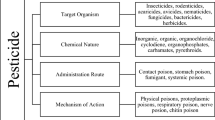Abstract
We studied the 14C-tagged biochemical compartments such as proteins, lipids and polysaccharides from bacterial and fungal cultures supplied with 14C-pesticides and 14C-glucose. We showed that 14C incorporation depends both on the substrate structure and on the nature of the micro-organism. Both bacterial and fungal cells incorporated glucose 14C mainly into cell wall proteins. By contrast, glyphosate 14C was mainly incorporated into cytoplasm carbohydrates by fungi. On the other hand, 2,4-dichlorophenoxyacetic acid 14C was mainly found in the carbohydrate fractions of the bacteria walls.



Similar content being viewed by others
References
Bollag J-M, Myers CJ, Minard RD (1992) Biological and chemical interactions of pesticides with soil organic matter. Sci Total Environ 123:202–217
Dec J, Haider K, Benesi A, Rangaswamy V, Schäffer A, Plücken U, Bollag J-M (1997) Analysis of soil-bound residues of the 13C-labeled fungicide cyprodinil by NMR spectroscopy. Environ Sci Technol 31:1128–1135
Dignac M-F, Zegouah Y, Loiseau L, Bardoux G, Barriuso E, Largeau C, Derenne S, Mariotti A (2003) Pyrolytic study of the non-extractable residues of 13C-atrazine in soil size fractions and soil humin. In: Ghabbour E, Davies G (eds) Humic substances: nature’s most versatile materials. Taylor & Francis, New York, in press
Gunalan G, Fournier J-C (1993) Effect of microbial competition on the survival and activity of 2,4-D-degrading Alcaligenes xylosoxidans subsp denitrificans added to soil. Lett Appl Microbiol 16:178–181
Guthrie EA, Bortiatynski JM, Van Heemst JDH, Richman JE, Hardy KS, Kovach EM, Hatcher PG (1999) Determination of [13C]pyrene sequestration in sediment microcosms using flash pyrolysis-GC-MS and 13C NMR. Environ Sci Technol 33:119–125
Johnsen AR, Winding A, Karlson U, Roslev P (2002) Linking of microorganisms to phenanthrene metabolism in soil by analysis of C-13-labeled cell lipids. Appl Environ Microbiol 68:6106–6113
Loiseau L, Barriuso E (2002) Characterization of the atrazine’s bound (nonextractable) residues using fractionation techniques for soil organic matter. Environ Sci Technol 36:683–689
Loiseau L, Barriuso E, Zegouagh Y, Largeau C, Mariotti A (2000) Release of the atrazine non-extractable (bound) residues of two soils using degradative techniques. Agronomie 20:513–524
Madigan MT, Martinko JM, Parker J (1994) Metabolism, biosynthesis and nutrition. In: Brock TD (eds) Microbiology of microorganisms, 7th edn. Prentice Hall, Carbondale, pp 89–119
Scheunert I, Schröder P (1998) Formation, characterization and release of non-extractable residues of [14C]-labelled organic xenobiotics in soils. Environ Sci Pollut R 5:238–244
Acknowledgements
This research was supported by the INSU program and the EGER Institute. We thank H. Jean-Jacques for her technical assistance.
Author information
Authors and Affiliations
Corresponding author
Rights and permissions
About this article
Cite this article
Charnay, MP., Mougin, C., Farrugia, A. et al. Incorporation of pesticides by soil micro-organisms as a way of bound residues formation. Environ Chem Lett 2, 27–30 (2004). https://doi.org/10.1007/s10311-003-0055-2
Accepted:
Published:
Issue Date:
DOI: https://doi.org/10.1007/s10311-003-0055-2




